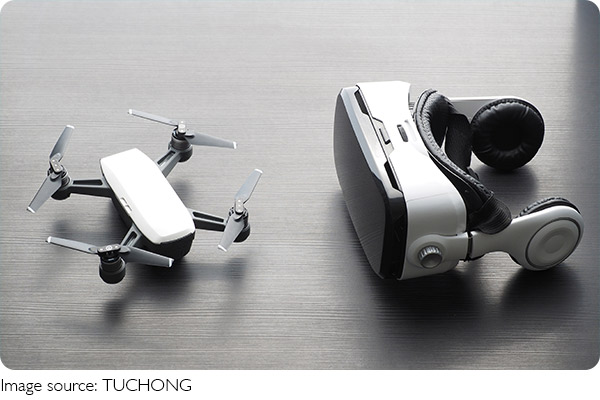Sci-Fi Made Real

The first time I saw a hologram call on a phone, I froze. It wasn't a movie—it was a live demonstration. The person appeared in 3D above the device, talking in real time.
That's when it hit me: the gadgets we dreamed of in sci-fi films are no longer fiction. They're quietly becoming real—and some are already in people's homes or pockets.
In this article, we're going beyond smartwatches and wireless earbuds. We're diving into gadgets that feel like they shouldn't exist yet—but they do. From wearable translators to robot pets with emotions, here are the most fascinating devices that blur the line between reality and science fiction.
1. Real-Time Language Translators
Imagine traveling to another country and holding a conversation without knowing a single word of the language. That's now possible thanks to wearable AI-powered translators like the Timekettle WT2 Edge or Pocketalk.
How it works:
• You wear one earbud, and your conversation partner wears the other.
• It translates both sides of the conversation in real time.
• Some devices support over 80 languages and use cloud-based AI to learn dialects and tones.
For frequent travelers, international students, or businesspeople, this kind of gadget is more than cool—it's life-changing.
2. Smart Contact Lenses with AR
Augmented reality (AR) used to mean bulky headsets. Now, companies like Mojo Vision are developing smart contact lenses that could display digital info directly in your field of view.
What makes it feel sci-fi:
• These lenses include micro-LED displays, sensors, and wireless chips.
• They aim to overlay health data, navigation, or even real-time subtitles onto your sight.
• They're powered by tiny batteries that recharge wirelessly.
Though still in testing, the idea that your eyes can become a digital interface is something we've only seen in sci-fi—until now.
3. Holographic Communication Devices
We've long imagined holograms through films like Iron Man. Now, companies such as PORTL and Looking Glass are turning that vision into commercial reality.
These devices can:
• Project 3D life-size holograms of people in real time.
• Be used for virtual meetings, interviews, and even concerts.
• Create “presence” without being physically present.
Some startups are even exploring holographic cooking classes and personal coaching experiences using these devices.
4. AI-Powered Home Robots
You might think of home robots as simple vacuums, but newer models do far more.
Take Astro by ElliQ, an AI-powered robotic companion for older adults.
Key capabilities:
• Navigate homes, remind users to take medicine, and provide emotional companionship.
• Recognize voices and respond conversationally.
• Learn routines and adapt based on user behavior.
It's not quite Rosie the Robot from The Jetsons, but it's impressively close—especially for people needing assistance at home.
5. Brain-Controlled Headsets
This one sounds like it belongs in a sci-fi thriller: devices that read your brainwaves to let you control tech without touching anything.
Products like Neurable and NextMind offer brain-computer interface (BCI) headsets that let you:
• Navigate computer interfaces using only thought.
• Play games hands-free.
• Measure focus and mental fatigue in real time.
In fields like therapy and accessibility, this technology could unlock new tools for people with mobility or speech limitations.
6. Gesture-Control Rings
If you've ever wanted to feel like you're casting spells, gesture-based smart rings may be for you.
Devices like Fin Ring let you:
• Control smart home devices with hand movements.
• Navigate slideshows or music with subtle finger gestures.
• Trigger voice commands without pulling out your phone.
They may look like fashion accessories, but they're packed with sensors and Bluetooth tech that turn your hands into remotes.
7. 3D Printing Pens and Food Printers
Holding a pen and drawing in the air sounds made-up—but 3D printing pens like the 3Doodler make it possible.
What they can do:
• Melt and cool plastic instantly to draw 3D objects in mid-air.
• Help create models, art, or prototypes at home or in classrooms.
Even more futuristic: 3D food printers like Foodini that create edible meals by layering ingredients. It's still niche, but it's redefining how we think about cooking.
What These Gadgets Mean for Us
We used to think of flying cars or teleportation when we heard “sci-fi tech.” But in reality, innovation is sneaking in through smart, small, and deeply useful gadgets that integrate into our daily routines.
They're reshaping how we:
• Communicate across languages and time zones.
• Navigate digital spaces and physical ones.
• Take care of ourselves and others.
According to Kevin Kelly, founding editor of Wired Magazine, “The future happens gradually, then suddenly.” These gadgets are that “suddenly”—quiet but profound shifts in how we live.

Which Gadget Feels the Most Sci-Fi to You?
Lykkers, have you come across a gadget recently that made you stop and think, "This can't be real!"? Maybe a robot vacuum that talks back, or a pen that draws in the air?
What once lived in movies is now showing up on store shelves—and in some cases, in our homes. The future didn't knock loudly. It just slipped into our lives one device at a time.
And now that it's here… what would you try first?
-
 Abstract Art AppealWhy do abstract artworks attract us—even when we can't "figure them out"?
Abstract Art AppealWhy do abstract artworks attract us—even when we can't "figure them out"? -
 Epic Balkan Road AdventuresMountains, coastlines, and medieval towns—ready to chase freedom across borders and discover the Balkans like never before?
Epic Balkan Road AdventuresMountains, coastlines, and medieval towns—ready to chase freedom across borders and discover the Balkans like never before? -
 Car Regulations EvolvingRegulations Are Reshaping Cars Forever — The Surprising Truth Behind the EV Revolution!
Car Regulations EvolvingRegulations Are Reshaping Cars Forever — The Surprising Truth Behind the EV Revolution!